Storm sewer cleaning technology: a review of popular methods
Owners of dachas and country houses know firsthand how important it is to equip storm drains so that melt and rainwater do not spoil the finishing and flood the foundation. But it is not enough to organize a proper wastewater disposal system - without regular maintenance, it will quickly fail and “report” this with streaks on the walls and puddles near the house during a heavy rainfall or a spring drip.
To prevent this from happening, it is necessary to carry out timely prevention and be able to quickly remove blockages. Therefore, we will consider in detail what methods the technology for cleaning storm drains has, depending on the type of its design. Also in this article we focus on the causes of clogged drainage systems and preventive measures.
The content of the article:
Types of storm drainage
The purpose of storm drains is to collect water from fallen precipitation and discharge it into a special reservoir or simply outside the site through a pipeline network or drainage gutters. Any drainage design can cope with this task.
But in order to choose the most effective way to clean and prevent sewer blockages, you first need to find out which system protects your home from rain and melted snow.
Open (surface) is the most cost-effective and simple design that is used to equip country houses. It is a complex of trays, pipes, gutters that run along the roof and walls of the building - weir system. Through them, water enters water intake points - surface drainage ditches, equipped along the perimeter of the entire site or just the local area, and is discharged into the ground.
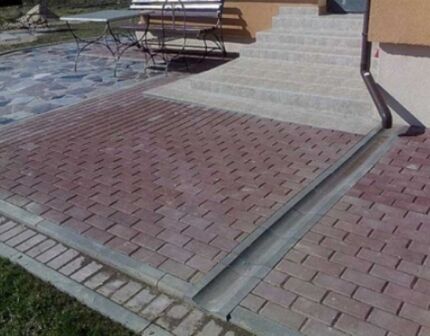
Closed - the upper part of the storm drain represents the same system of pipes and gutters, only the collected water is collected in underground sewer pipes, where other wastewater from the house also flows, then into the collector, and only after that it is discharged into the drainage system. In some cases, a pump is additionally installed that regulates the speed of movement of the wastewater.
This system does an excellent job of removing excess moisture from the site without flooding the soil, forming puddles and other flaws in the operation of open storm drains. The disadvantages include expensive installation.
In addition, for a non-professional it may be an overwhelming task to correctly calculate the required number of components, the length and diameter of pipes, determine the depth of their installation, the required slope and other nuances. We provided a detailed analysis of the design and calculation features of storm sewer systems In this article.
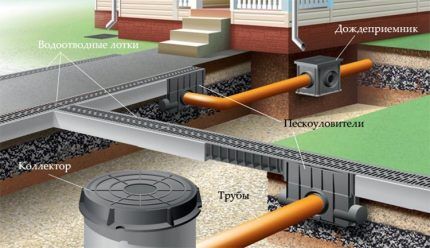
Therefore, for country cottages and country houses designed for a longer period of residence than a couple of weekends a year, a mixed sewage system is most often installed. Essentially, this is a simplified version of a closed system
In this case, instead of a complex sewer labyrinth, the water is diverted into a storage tank or septic tank, located on the territory, is settled, cleaned and can then be used for irrigation or other technical purposes.
Another option for recycling wastewater is to discharge it into nearby lakes and rivers, but for this, the water must undergo filtration so as not to clog the reservoir (which is fraught with an impressive fine).
Causes of clogged drainage systems
Any system, regardless of its type of construction, is regularly penetrated by various small debris - fruit tree seeds, insects, fallen twigs and leaves, bird feathers and nesting material.
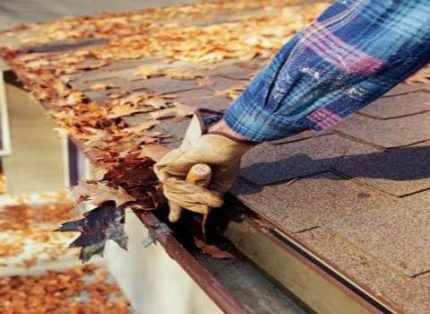
But there are other causes of blockages:
- Incorrect installation. If the pipeline does not maintain the required angle of inclination towards the water collector (or is absent altogether), the water will stagnate and debris will accumulate faster. You can verify compliance with the standards using a building level (the optimal indicator is 2-5 mm/linear meter).
- Curvilinear pipe laying. If the system has many sharp turns, blockages are inevitable. Therefore, when planning the pipeline, try to keep bends to a minimum. Yes, and it’s useful when independent design or when accepting work from builders, you will first have to familiarize yourself with SNiP 2.04.01-85.
- Heavy rainfall. After a heavy rainfall, the system may become flooded with fine sand, silt or mud. It is difficult to prevent natural disasters, but it is recommended to check the operation of the system after them and arrange unscheduled cleaning.
- General blockage. For closed systems in which the storm sewer is connected by a pipeline that removes household waste, the problem can most often be solved by cleaning the house pipe.
- Construction works. If the roof was covered or the façade decoration was renewed, upon completion of the repair it is necessary to check whether the wind has blown polystyrene foam, fragments of plaster and other materials into the gutters and pipes, which in the next rain will turn into an impassable plug for water.
In some cases, the cause of blockage may be the penetration of petroleum products into the system. True, this phenomenon can be attributed to force majeure, which disables storm drains much less often than the banal accumulation of leaves.
But if this happens, you should immediately call specialists who will adjust the system’s operation and prevent contamination of the soil and groundwater.
Methods for cleaning systems
Depending on the drainage design devices and the type of its elements (the same gutters can be completely open or closed, but with meshes or perforations), you can choose the most convenient way for you to care for the system.
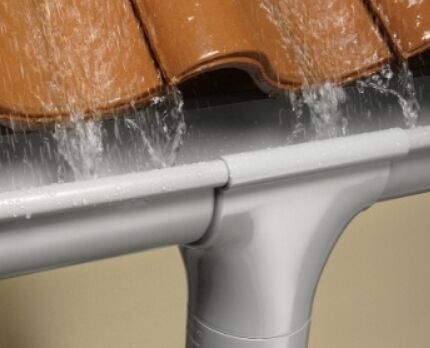
Let's look at all the different methods in more detail.
Method #1 - mechanical using improvised means
The most affordable and popular cleaning method, which is perfect for all open storm drains, is mechanical. It does not require any special equipment or special skills, except perhaps caution when working at heights. The essence of the work is the mechanical removal of accumulated debris.
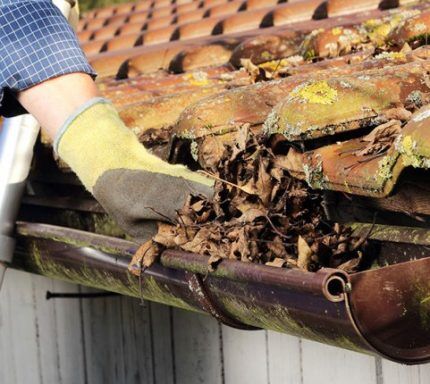
To complete this task, you will need simple equipment: a ladder, a brush with bristles made of plastic or synthetic fibers, a spatula or dustpan, a garden hose with a water connection.
You can make an excellent tool with your own hands from an ordinary plastic bottle by cutting a semicircular hole in it along the diameter of the gutter. Just before you start cleaning, do not forget to protect your hands with thick gloves to protect yourself from sharp fragments and insects.
Cleaning should be carried out from the highest point, covering all elements of the system:
- From the gutters laid on the roof, the accumulated garbage must be raked onto a scoop and placed in a bag for further disposal. Just don’t push leaves and other debris into the drainpipes; it’s better to sweep everything out with a broom or brush, and then clean the surrounding area.
- Funnels - connecting elements that connect gutters and rain pipes - are most often equipped with grates that need to be removed and washed. If there is no such protection, you can simply clean the elements under water pressure, removing traces of dirt and small debris, and pre-collect large ones by hand.
- The drainpipes through which waste is directed downwards are also easiest to rinse under good pressure, using a brush to help yourself. If you can’t get the blockage out with your hands and a brush, and it doesn’t respond to water, you can use a plumbing drill or cleaning tapes. Only such equipment must be used with caution so as not to scratch the protective coating of the pipes, which leads to metal corrosion.
- Drainage channels must first be cleared of protective grilles (if installed), cleared of debris and rinsed with water.
- Now inspect the wastewater storage tank (ditch, drainage field), if necessary, remove the sludge and update the filter layer.
- All that remains is to return all the grilles and other elements of the system and check its operation using the same hose with water pressure.
Specialized cleaning machines of the sectional, rod or drum type can make manual labor easier, although they are more designed for removing blockages in pipes rather than cleaning open gutters.
But there is also an option for those who do not want to collect leaves themselves - a robot vacuum cleaner.

Once you install this miracle of technology on the roof, it will begin to move around the perimeter of the gutter system, removing dirt and debris accumulations with brushes. Can be powered by electricity or batteries.
Method #2 - rinsing with water pressure
A closed or mixed system can also be cleaned mechanically at the top (above ground) part. True, you will have to make preliminary preparations - remove the nets or grates from the gutters, arm yourself with a brush on a long stick or a blower.
But to clean an underground drain, you may need hydraulic equipment. A simple garden hose is no longer enough here, since its pressure is not enough to break up plugs of sand, dirt and wet leaves. Hydraulics provide a powerful water jet, which perfectly washes out simple debris from the pipeline.
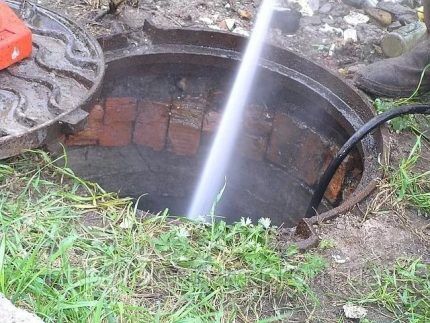
And you can detect a blockage through inspection wells or using video diagnostics - modern devices are equipped with a sensor and a cable, which, passing through the pipes, makes a recording or immediately transmits to the display an image that clearly demonstrates the condition of the sewer from the inside.
Typically, systems for country houses and small houses are equipped with elements with a diameter of 20-22 cm. To flush such a sewer, a household car wash with a power of 120-150 bar is sufficient.
But to clean the wide pipes that large cottages are equipped with, you will have to call in specialists with professional hydraulic equipment, which is equipped with a long hose and a powerful pump.
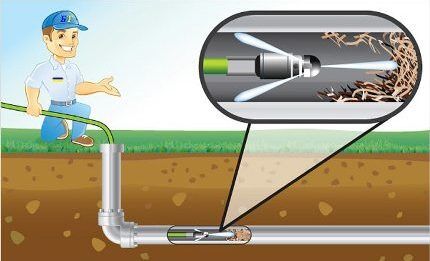
Professional hydraulic machines are also equipped with nozzles that can cope with both simple and complex types of blockages:
- Universal – used for routine drain cleaning and removal of soft debris.
- Bottom – effectively remove leaves, pieces of polyethylene, soil, silt and other accumulations from storm drains.
- Punchy – designed for crushing construction waste, accumulation of leaves and branches, sand, paper.
- Carousel-chain – will cope with old deposits and caked debris that do not respond even to strong water pressure.
To use the hydrodynamic method of cleaning pipes, the site must have an uninterrupted supply of water and electricity. Otherwise, you will have to look for equipment that runs on gasoline, or call a car with a tank.
But this technology, unlike other methods of sewer cleaning, absolutely guarantees the integrity of all drainage elements.
Method #3 - thermal or steam cleaning
For mixed and closed systems combined with public sewerage, steam cleaning technology can be used.Blockages often occur here due to fatty growths on the walls of the pipeline, which do not respond to cold water, but literally disappear before our eyes under the influence of hot steam. To do this, water is heated to a temperature of 140 degrees and flushes the pipes.
But keep in mind that the thermal method is recommended to be used as the final stage after mechanical and hydrodynamic cleaning. But it should not be used as an independent method - the risk of injury is high, and the result is unpredictable.
Method #4 - use of chemical reagents
In cases where other cleaning technologies are powerless against complex blockages, they resort to chemical reagents.
Such a need may arise if a large amount of greasy waste has penetrated into the system, which has stuck together into dense lumps with the debris present there, or the design is so complex and tortuous that the plug is technically inaccessible to cables with punching attachments, but water does not cope with the task.
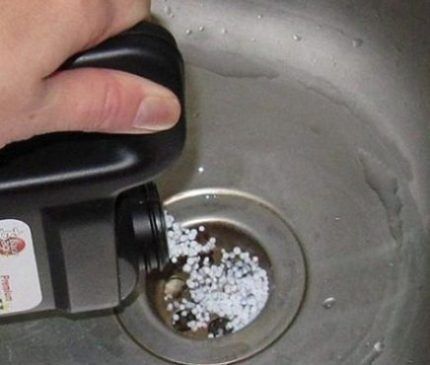
You should use such chemicals yourself with caution - most of them are toxic and, if they penetrate into groundwater, can cause severe poisoning. Therefore, sewerage can be cleaned using this method only with biochemical preparations, and only on the condition that the contaminated water first undergoes filtration and does not end up in drinking water sources.
Methods for cleaning storm drains directly
Cleaning the storm sewer directly involves periodically emptying the sand traps and removing plugs of silt and sand from the channels of the underground system:
What is the danger of system clogging?
If, after studying all the technologies for cleaning storm drains, you are seriously thinking in the direction of “do I need it,” take note of the list of problems that can result from lack of care for the system.
- Stagnation of water masses in pipes and gutters creates additional stress on fastening elements. They may simply not be able to stand it and bring down the system.
- The accumulated debris clogs the drains, and water not only erodes the foundation of the house, but also penetrates through the ceilings and walls - yes, damp spots and moldy trim can be a clear indication of problems on the roof.
- Fallen fruits and berries create favorable conditions for the settlement of entire colonies of wasps, hornets, ants, and moss, mold and even mushrooms can grow under wet leaves.
- In dry summers, debris on the roof may well cause a fire.
As you can see, regular cleaning of storm drains is not only a matter of comfortable living in the house, but also of your safety.
Measures to prevent blockages
Experts recommend checking the operation of open storm drains and removing accumulated debris at least 2 times a year.After the autumn leaves fall, you need to remove all debris to prepare the drainage system for winter, and in early spring, make sure the integrity of the fastenings after frost and thaw.
But when there are tall trees near the building, you will have to look at the roof much more often if you do not want to find out about the need to clean up the water flowing down the walls and from the roof of the house, bypassing the rain pipes. But if all the gutters are in a closed type structure, one inspection per year is quite enough.
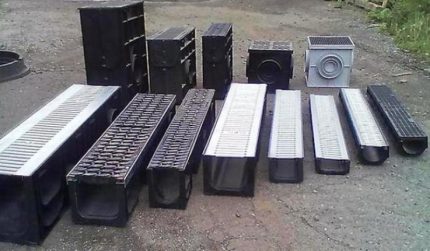
The following preventive measures will help prevent blockages:
- Special canopies for funnels and fine-mesh meshes/grids covering gutters will help reduce the amount of debris entering the drainage system. If the system is already installed and there is no desire to modernize some of its elements, you can fill the gutters with porous foam. It is applied by spraying, takes the form of a drain and does not allow large debris to enter the pipes (however, such protection needs to be updated every 3-5 years).
- Since an external storm drainage system is much easier to clean than an underground one, you can equip the drains with several catch grates that will stop soil particles, sand and leaves. To prevent blockages, it will be enough to regularly check the “control points” and remove debris from them.
- If a closed or mixed type system is installed on your site, it is worth installing in the pipes that lead domestic wastewater out of the house, grease traps. This will help avoid difficult-to-remove formations on the walls of the sewer.
- If the underground part of the system has complex turns, it is worth installing inspection wells in potential places of blockages, so that if problems arise, you do not have to dig up the pipes.
In addition to additional protection of the system, it is worth taking care of wastewater treatment. To do this, you need to equip sedimentation tanks with drainage fields or separators that mechanically separate water from sediment and other impurities, or install an autonomous sewage system.
Conclusions and useful video on the topic
More details about organizing the drainage system on the site:
And this video describes in detail how to install a mesh to protect the drain from leaves with your own hands:
Professional cleaning using hydrodynamic technology - how complex blockages are washed out:
Compliance with building codes during installation, regular waste removal and prevention are the three elephants for the smooth operation of the entire sewer system.
But if none of the popular cleaning technologies have inspired you to perform feats of labor, it is worth agreeing with a cleaning company regarding periodic cleaning of the storm drain. Believe me, such a service will cost much less than removing caked blockages and repairing a flooded house.
What method of cleaning storm drains do you use? Do you take preventive measures to prevent blockages? Share your secrets of caring for a common house sewer system with other users - leave your comments and useful tips in the comments block.




It is clear that storm drains need to be cleaned. However, I prefer mechanical methods, since chemical ones can damage the very materials used in the construction of the system.That is why I would recommend that those who have a lot of deciduous trees on their property use open storm drainage options. At least in such cases, mechanical cleaning will be most effective.
There was a blockage in a closed pipe; at first we wanted to use the service of a company that rented out a sewer flushing machine. But they are so expensive. What if this happens all the time? We asked a neighbor for a car wash, bought a longer high-pressure hose and cleaned everything well. After that, we installed a rubber debris catcher in front of the pipe, the problem did not recur. If the mesh becomes filled with dirt, you just need to shake it off.
A classic example of how a person solved the symptoms and then eliminated the very cause of the problem :) In this case, we can say that if the garbage catcher had been installed immediately, there would have been no problems at all. For those who constantly have problems with clogged storm drains, your example is very clear.
To catch leaves and other large debris, a drain with a grate is sufficient, but it is also necessary to equip the drain with a special sand trap. This integrated approach will help avoid critical blockages in storm drains.
I have a lot of deciduous trees in my dacha and the pipes are constantly getting clogged. My neighbors recommended contacting a company that specializes in servicing storm drains, and they really helped, now there are no problems with blockages.